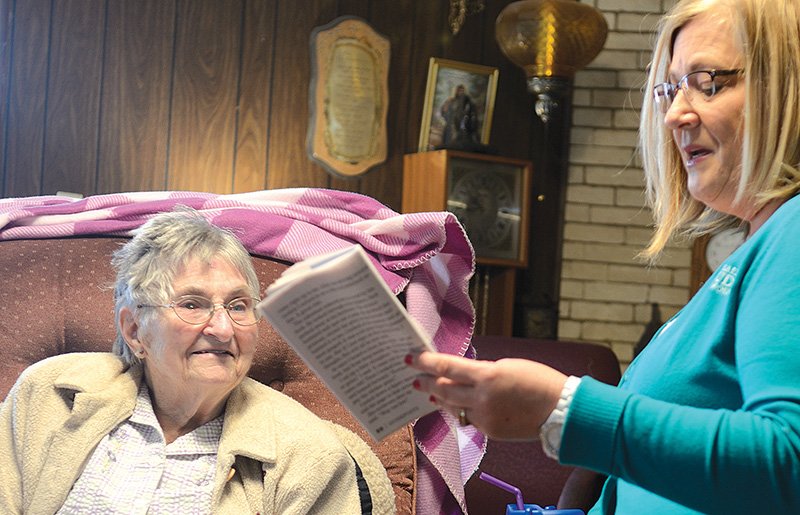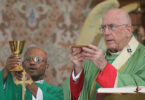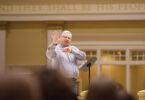
Hospice patient Bernice Stirton, left, looks forward to visits from Saint Jude Hospice volunteer coordinator Shawn Gigstad and time spent together reading inspirational stories from Guideposts magazine. Photo by Jill Ragar Esfeld.
by Jill Ragar Esfeld
NORTONVILLE — Several years ago here, St. Joseph parishioner Shawn Gigstad asked her longtime friend and cousin Sister Paula Rose Jauernig if she could pinpoint the most rewarding experience of her vocation as a Sister of Charity of Leavenworth.
The answer would not only surprise Gigstad, but would change the direction of her life.
“One of the most rewarding,” said Sister Paula Rose, “was the time I spent working in hospice care.”
Gigstad had spent the first part of her working life serving children — as a schoolteacher and then as director of her parish religious education program — while she raised her son.
“I really felt a calling somewhere else now,” she said.
Reflecting on Sister Paula Rose’s words, she decided to try her hand at serving those on the opposite end of the age spectrum, in the last months of their lives.
“So, about a year and a half ago,” she said, “I contacted Saint Jude Hospice and said I would like to be a volunteer.”
A rewarding experience
Saint Jude Hospice has offices in Topeka and Hiawatha and covers 17 counties in Kansas (see map). Though Catholic, it accepts patients of any faith.
Saint Jude provides care wherever the patient calls home — whether that is a private residence, an assisted living facility, or a nursing home.
Gigstad said her inspiration to contact Saint Jude Hospice specifically stemmed from a discussion she had with a friend whose father was near death.
“She wasn’t a practicing Catholic,” said Gigstad. “But her dad was, and she had no idea on the religious directives of the Catholic Church for end of life.”
Saint Jude Hospice adheres to the “Ethical and Religious Directives for Catholic Health Care Services.”
“That’s what really drove me,” said Gigstad. “I thought there must be a lot of people out there that are my age, and their parents are dying. “They have no idea what to do according to their parent’s faith.”
It didn’t take long for Gigstad to become an advocate for the rewarding experience of being a hospice volunteer.
“My thoughts of hospice have completely turned around,” she said. “I think it’s a huge privilege to be invited into somebody’s last days.
“And this has helped me to overcome my own fear of dying.”
Like many people who work with the dying, Gigstad has been educated on the process and has come to see it in a positive light.
“It’s just so natural and not so scary,” she said. “This life isn’t the best we have — there’s better to come and there’s a peaceful transition.”
Joining the team
Lynnea Andersen, assistant vice president of psychosocial care at Saint Jude Hospice, understands how Gigstad feels.
A social worker by trade, Andersen has been a part of hospice programs for 16 years. When she took her first job, she thought it would be depressing.
“It is so far from depressing,” she said. “Sure, it is sad when our patients die — we feel for our families. But the opportunity and the blessing it is to be able to go in and provide much-needed support to a patient and the family is just priceless.”
Anderson says that Gigstad has a servant’s heart, and that’s all a good hospice volunteer really needs.
“It’s a true blessing to be able to be a part of people’s lives when they truly need you,” she said. “And to work with an organization that believes in the value system of the Catholic Church is a blessing.”
After seeing the dedication and drive displayed during her first year volunteering, Saint Jude Hospice hired Gigstad as its volunteer coordinator.
Gigstad was thrilled to become part of a company that is “on fire for Christ.”
“Everyone is so positive,” she said. “Every meeting, every phone call starts with our company values. And those are: outstanding customer service, integrity in our actions, nothing is impossible with God, kindness in our relationships, and excellence in everything. All that is really reinforced in everything we do.”
An invitation
Gigstad is now reaching out to fellow Catholics in the archdiocese, inviting them to experience the joy of being a hospice volunteer.
Federal law requires that for a hospice to receive Medicare and Medicaid reimbursement, at least 5 percent of patient care hours must be provided by volunteers. Ideally, Saint Jude would like to recruit more volunteers than patients, so patients have extra care.
“And we’re really targeting our Catholic parishioners,” said Andersen, “because a lot of time we have patients who would like someone to pray the rosary with them.”
Volunteers can give whatever time they have available. After hours of training, plenty of support is provided by Gigstad.
“I go out to the facility [or home] with the volunteer and introduce them to the patient,” she said. “We do a care plan,” added Andersen. “That goes over what the patient’s wishes are — what they would like a volunteer to help with.”
Volunteers fill out a patient log sheet after each visit, which Gigstad enters into a computer and copies for the patient’s file.
The strength of hospice is its team approach. The volunteer is part of a team of professionals providing different aspects of care. Teams stay in contact, with interdisciplinary team meetings every two weeks to discuss patients’ progress.
But that’s not something volunteers need to figure into their time.
“The volunteers report to me,” said Gigstad. “As the volunteer coordinator, I will report to the team.”
If a volunteer doesn’t feel called to work directly with patients, there are many opportunities to help out with office tasks, make phone calls, or pray for families.
Volunteering for Saint Jude Hospice is simply a matter of making new friends and being with them when they need you most, said Gigstad.
“If you can just provide some normalcy to their day,” she said, “that’s a huge reward to them. And I think, in return, to you.”
“It’s a wonderful opportunity to give back,” said Andersen. “You definitely get more out of it than you put in.”






